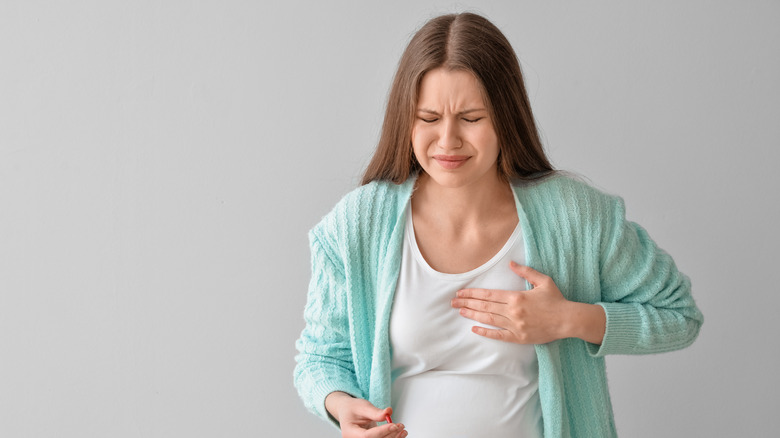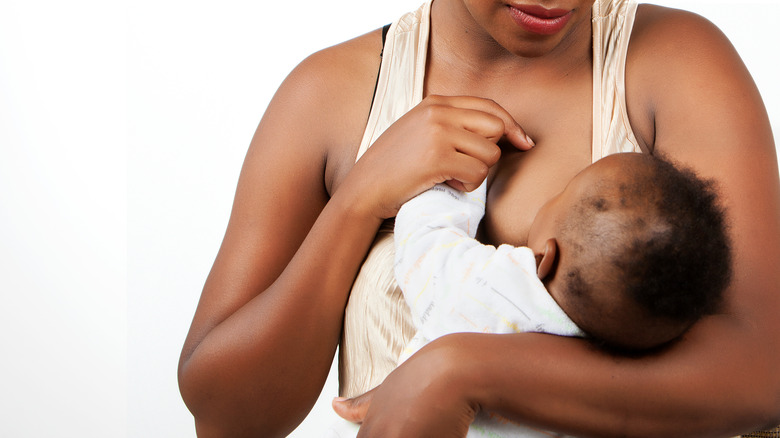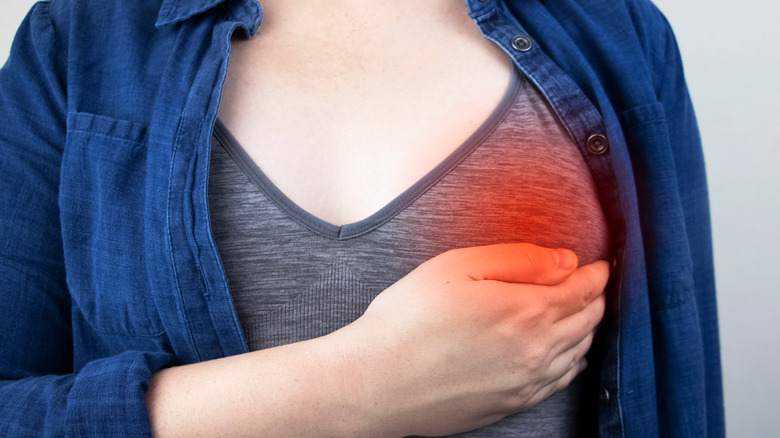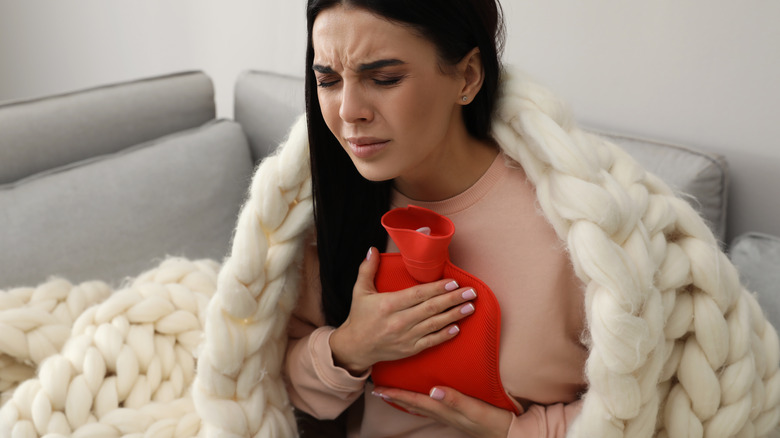Mastitis Explained: Causes, Symptoms, And Treatments
When a new infant is brought home, mothers have an infinite number of things to worry about. They are protectors from every little harm and sickness, making sure that their baby is well-rested, bathed, and fed, even when that means they don't have the time or energy to do so for themselves. That is why when mastitis comes knocking, it turns a mother's world upside down; caring for children while yourself being shivery, nauseous, and in excruciating pain feels impossible.
First-time breastfeeding mothers may not yet understand what is happening when they wake up to a swollen, painful, red breast. This condition can commonly crop up during the first three months of breastfeeding (via Cleveland Clinic), when you start pumping (per Seattle's Child), or when you're attempting to wean (via VinMec International Hospital). Some victims of mastitis aren't even breastfeeding — or even female, adds the Mayo Clinic. Anyone with breast tissue and milk ducts (yes, that includes males) can develop mastitis, so here's everything you need to know about how to spot this painful inflammation, what causes it, and how to treat it.
Mastitis is an inflammation of breast tissue
Inside every breast is an intricate system that produces and stores breast milk in a lactating person. Tiny, thin tubes called milk ducts link all of the components together, and these ducts all lead to the center of the nipple where the breast milk is expelled (via Johns Hopkins Medicine). Mastitis is a condition in which the milk ducts within the breast become clogged, leading to an inflammation of the surrounding breast tissue, and possibly an infection.
According to the Cleveland Clinic, mastitis is a form of benign, or noncancerous, breast disease. Mastitis is a curable, temporary inflammation of tissue that in the vast majority of cases leaves no lasting effects after being cured. While this inflammation may in some instances go away without medical treatment, it's best to pay careful attention to this condition and seek a physician's advice on your treatment plan so that no complications occur.
There are different types of mastitis
Mastitis is the term for the general condition of inflamed breast tissue, but it can be broken into more specific types, according to Acute Mastitis. Mastitis is either lactational (also known as puerperal) or non-lactational (nonpuerperal) mastitis. The former occurs in someone who is lactating and/or breastfeeding, and the latter describes a case where the patient is not lactating or breastfeeding.
There are two subtypes of non-lactational mastitis: idiopathic granulomatous mastitis (IGM), and periductal mastitis. As Acute Mastitis notes, non-lactational periductal mastitis still occurs most frequently in reproductive-aged women, although it can affect anyone with breast tissue, including men. While both of these conditions are benign, the symptoms of IGM are similar to those of breast cancer. There isn't a definite cause for either of these mastitis types, unfortunately, although certain risk factors such as smoking, obesity, diabetes, and autoimmune diseases are thought to increase one's vulnerability.
Mastitis is often caused by blocked milk ducts during breastfeeding
The majority of mastitis patients are breastfeeding mothers. According to the Children's Hospital of Pennsylvania, this painful, frustrating condition is mostly likely to occur within the first six to 12 weeks of breastfeeding, which unfortunately is also the most challenging time when mother and baby are still getting familiar with each other and the process (via Medela). While engorgement — when the breast becomes firm to the touch and slightly painful due to an overproduction of milk, or the first time a mother's production switches from colostrum to milk, explains The Youth Clinic — is not on its own one of the signs of mastitis in breastfeeding moms, it can lead to mastitis if unaddressed.
In a breastfeeding parent, mastitis is often triggered when a milk duct gets clogged with thickened milk as a result of milk drainage issues (via Mayo Clinic). This could be a result of stress, issues with latching and nursing, tight bras and clothing, or too many missed feedings. The body will continue to produce milk, creating a painful backup in the clogged duct. This will result in inflamed breast tissue, which will be sore and swollen. However, this stage more often than not is still non-infective mastitis, Children's Hospital of Pennsylvania says, although if left too long the inflammation can result in an infection.
There are other causes of mastitis
When mastitis is infective from the start, this means that bacteria has entered the sensitive inner structure of breast tissue through chapped, cracked, or otherwise wounded nipples and milk duct openings. Nursing women are also susceptible to this type of mastitis, because the stored breastmilk is a breeding ground for bacteria, the Mayo Clinic explains. Rather than inflammation leading to infection by trapping milk in clogged ducts, the presence of bacteria leads to inflammation, redness, and pain. If you suspect that your mastitis is infective, the condition will very likely need antibacterial intervention to be cured.
Inflammation of breast tissue can also be chronic, especially in postmenopausal women, says WebMD, or women who've had lumpectomies followed by radiation therapy, according to Johns Hopkins Medicine. Chronic mastitis isn't caused by breastmilk, may be a result of other underlying conditions, and is usually managed with antimicrobials and surgical drainage (via Journal of Family & Community Medicine).
Mastitis can affect men and non-breastfeeding women
Although cases of mastitis in these patients are far more rare, neither men nor women who aren't breastfeeding are not entirely protected from inflamed breast tissue, says the Mayo Clinic. These folks might get mastitis for one of a couple reasons. Galactorrhea, a condition where a non-pregnant or breastfeeding person lactates due to an overproduction of the hormone prolactin, can cause mastitis if that discharge becomes trapped within the milk ducts or is introduced to bacteria. Plasma cell mastitis, or PCM, is a term used to describe inflammation of breast tissue that occurs in nonpregnant, nonlactating people. According to one review article, this is an autoimmune disease where patients' breast tissue becomes inflamed due to infiltrated plasma cells. This condition is often misdiagnosed as another disorder of the breast, the university researchers report, but causes all of the same painful symptoms as lactating mastitis over extended periods of time.
Sexual activity, shaving, and nipple piercings can introduce bacteria
There are certain things to steer clear of if you're doing everything possible to avoid mastitis. According to the Cleveland Clinic, shaving or plucking those pesky hairs around the nipple and areola, while tempting, can leave small openings into the highly sensitive milk ducts and tissue that lie beneath the skin. Similarly, according to a review published in the European Journal of Breast Health, nipple piercings can cause both infectious and noninfectious mastitis, although the latter is more infrequent. They are, after all, open puncture wounds that act as wide-open gateways for bacteria, germs, and pathogens to enter the breast tissue, especially if you become pregnant shortly after being pierced.
As Mayo Clinic points out, pathogens entering your body through an open milk duct or cracked skin is a common cause of mastitis. In the majority of cases, this would be bacteria from a baby's mouth. Though rare, mastitis can also be caused by pathogens from the mouth of a sexual partner, as in this case of a woman who developed mastitis due to the herpes simplex virus transmitted by her partner (via Journal of Hospital Medicine).
Risk factors for mastitis
Unfortunately, some lifestyle choices, habits, and health conditions may make you more vulnerable to mastitis. In some cases, this vulnerability is a result of foreign bodies in the area — breast implants or piercings — and in others, it's because of tobacco or nicotine use (via the Cleveland Clinic). Cigarette smoke can cause damage to the milk ducts underneath the nipple and slow down the healing and treatment process, says Breast Cancer Now.
Other health factors may also elevate your risk, including diabetes (or other autoimmune disease, explains the Cleveland Clinic) and eczema. According to a report published in the Australasian Medical Journal, those whose diabetes isn't well-regulated will be very susceptible to mastitis — and on the reverse, if the inflamed breast tissue becomes infected, their blood glucose levels will rise, destabilizing the diabetes.
Oral contraceptives and trauma to the breast can increase chances for non-lactational mastitis, according to Acute Mastitis.
Mastitis rarely affects both breasts
If there's one piece of good news about mastitis, it's that it's unlikely that you'll experience this painful inflammation in both breasts at the same time, explains What to Expect. Mastitis most often means that a milk duct is clogged, which is not something that is communicable from one breast to the other.
However, the chances that you'll get mastitis in both breasts at once are only slim — not zero. According to Cancer Therapy Advisor, bilateral or double mastitis will affect 3-12% of patients with mastitis. Double mastitis is most often caused by an aggressive pathogen such as methicillin-resistant S. aureus, or MRSA, says The Royal Hospital for Women. Additionally, according to a research review published in the Asian Journal of Surgery, bilateral mastitis is also possible in instances where patients are susceptible to breast tissue inflammation because of other health reasons.
Even if you have bilateral mastitis due to MRSA, you can likely continue to breastfeed, according to the CDC, as this bacteria cannot be passed to your baby via breast milk.
Mastitis is characterized by a red, swollen, painful breast and flu-like symptoms
So how can you tell that you have mastitis? The Mayo Clinic explains that you should look for pain in the breast accompanied by hot skin, a wedge-shaped red patch, and swelling. You may also notice an alarming lump or area of hard, thickened tissue in the affected area, white nipple discharge that may be streaked with blood, and a burning sensation while breastfeeding. Mastitis can impact your whole body and general energy levels. You're likely to experience flu-like systems, including a fever, chills and aches, and fatigue, adds the National Health Service (NHS).
These symptoms typically only last between two and five days, peaking on the second and third days (via the Children's Hospital of Philadelphia). However, you should see your doctor if 24 hours of consistent breastfeeding doesn't clear the issue, if your symptoms don't lessen within 48 hours after starting antibiotics, or if you have these symptoms and are not breastfeeding.
Physical exams can diagnose mastitis
Inflammation occurs when white blood cells and other fluids flood an area of your body to fight invaders such as bacteria (via WebMD). Because it is not a chronic condition for most people, mastitis inflammation is considered short-term, or acute. While the inflammation itself will not cause you harm — short-term inflammation is just a sign that all the good stuff in your body has arrived to battle back harmful invaders, explains Vanderbilt University — it's important to see a physician for a mastitis diagnosis to prevent infection or complications. To get your mastitis diagnosed and looked over, you can visit an urgent care center or walk-in clinic, a gynecologist, or your primary care physician, according to Mayo Clinic. If you are still in the early postpartum stages, your OB-GYN or lactation specialist can help point you in the right direction.
Your doctor will first ask you about your symptoms and then conduct a visual and physical exam of the breast, according to Family Doctor. Usually no further testing is needed, but if you are not breastfeeding and present with mastitis symptoms, the physician may want to conduct an MRI, ultrasound, biopsy, or mammogram to gather more information.
Treat mastitis with warm compresses and antibiotics
If you're diagnosed with mastitis, the most important thing to do is set yourself up for a few days of rest. Rest is your first and foremost prescription, explains The Lactation Network. Clearing your milk ducts is also paramount, so you should increase your breastfeeding schedule or express by hand or with a pump. You can also apply a heat compress to the afflicted breast several times a day — you can alternate with cool compresses if you find they bring relief, says Today's Parent. Family Doctor recommends massaging the area occasionally, starting behind the sore spot and moving in circles toward the nipple.
If your mastitis is infectious or severe, you'll be prescribed antibiotics, according to WebMD, which also advises that over-the-counter acetaminophen and ibuprofen are safe painkillers for breastfeeding if you are not given prescription-strength pain medicine. While various home remedies for mastitis exist, such as vitamin C supplements and applying cabbage leaves to the affected breast (via the Lactation Network), be sure to consult your physician on how these things can impact your breastmilk supply and your overall health.
You can (and should) still breastfeed with mastitis
Though it may be uncomfortable, it's recommended that you breastfeed through your mastitis (via Cleveland Clinic). Breastfeeding through the discomfort keeps your milk moving through the ducts, pushing the clog through. Experts recommend starting with the affected breast to ensure its milk supply is emptied out; frequently emptying the milk ducts will combat engorgement, which can make mastitis worse. The Lactation Network says you should breastfeed at least every two hours, and you can pump in between feedings to relieve pressure or fully drain the breast if necessary. Changing up your feeding position may put gravity on your side, ease your pain while nursing with mastitis, and give the baby a hand in draining the breast, especially if their success at nursing hasn't always been the best. Dangle nursing or dangle pumping means nursing or pumping from above your baby on your hands and knees, which taps in gravity to help draw the clog out.
Most important to note is that your mastitis will not affect the quality or your milk, nor can you harm your baby by nursing when you have mastitis (via the Cleveland Clinic). Your breastmilk is not contaminated and it will not make your baby sick. In fact, your milk contains some antibacterial magic that helps your vulnerable infant fight infections.
Mastitis can come back, especially in nursing mothers
While mastitis is not a forever diagnosis, it also unfortunately is not necessarily a one-and-done condition. You can get repeat cases of mastitis, says the Cleveland Clinic. However, multiple bouts with this condition may warrant a visit to a lactation consultant, as repeated breastmilk drainage problems can be indicative of problems with latching, suction, or position during nursing.
Once you've had mastitis once (or a couple times), you're definitely not eager to go through it again. Fortunately, there are ways to prevent this nasty sickness from striking you down again — since moms, after all, can't afford to lose momentum. Firstly, try to keep your nursing structured (we know, easier said than done). By keeping a breastfeeding routine as best as possible, you're preventing bacteria buildup in the ducts of your breasts; Kaiser Permanente recommends ensuring that you either nurse or pump every four hours.
You can also keep mastitis at bay by staying well-hydrated, avoiding tight or restrictive clothing, air-drying nipples after nursing, and treating sore, cracked skin with lanolin cream. A breastfeeding specialist can provide support in your baby's latching and positioning if mastitis is an ongoing issue and you suspect your baby isn't draining milk properly.
Untreated mastitis can cause abscesses
Without antibiotic treatment, you runs the risk of developing a breast abscess if your mastitis is accompanied by an infection (via London North West Healthcare). You'll know that your mastitis has progressed into an abscess if a red, hard mass full of fluid develops on the breast, the Cleveland Clinic explains. This lump will be significantly more painful than your mastitis has been previously, and you may also notice that your nipple has inverted and/or begun to drain a combination of blood and pus.
You should visit your doctor immediately if you suspect you have an abscess; they will likely order an ultrasound scan of the area and, if an abscess is located, it will need to be drained via a small puncture or incision, according to the NHS. After draining the abscess, most patients are able to go home the same day with a prescription for antibiotics.















